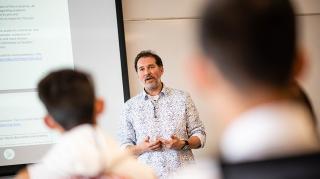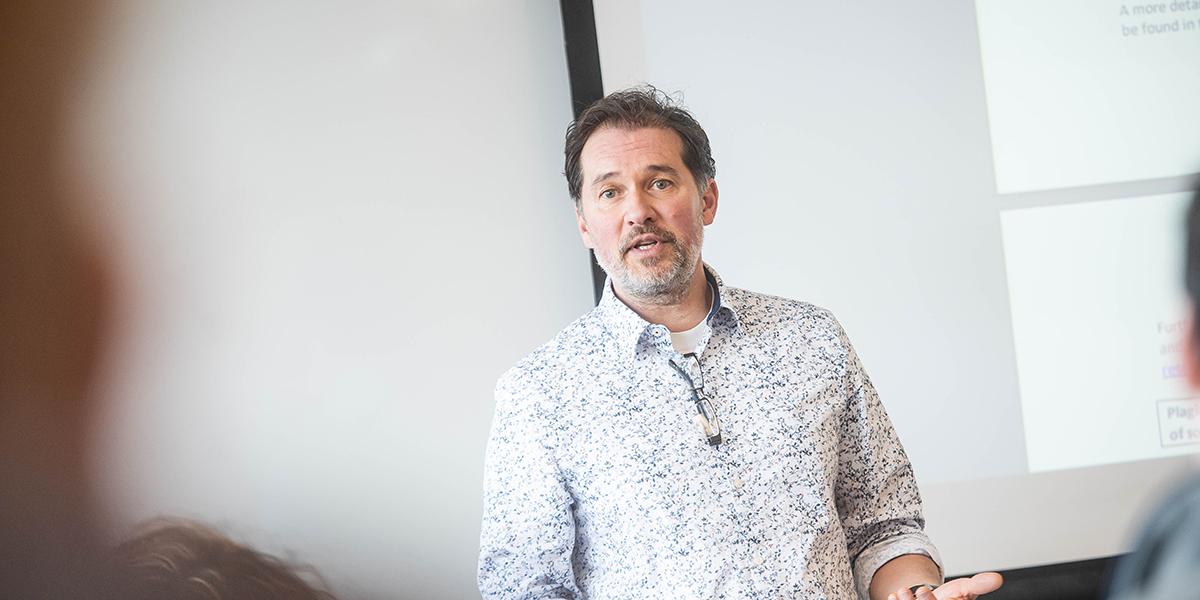Peering into the classroom


A glance at the computer monitor in John Vigna’s office is all it takes to realize the depth of dedication the Instructor (Fiction) and Pedagogy Chair of UBC’s Creative Writing Program has toward his role as an educator and mentor. Taped onto the screen, above the keyboard, is a print-out of the words: “How does this serve our students?”
It serves as a constant reminder, says John, who is in his 19th year of post-secondary teaching, of his values and goals as an instructor. “It’s the central question that’s at front of mind for every pedagogical choice I make, period,” he explains. “If I’ve learned about a great exercise or activity that I want to try in class—well, how is it going to best serve the students? I want to encourage and lead students into areas of their learning where they can assume responsibility for it and feel supported, without being told exactly what to do. This is absolutely essential for students learning the craft of writing fiction.”
"I felt that it was important that I rededicate and re-energize my teaching practice"
John Vigna
John’s commitment to teaching excellence goes much, much deeper than that piece of paper. Last summer he approached the Centre for Teaching, Learning and Technology (CTLT) with an unusual proposition: to invite faculty from across disciplines to sit in on every one of his large lecture classes in CRWR 209: Introduction to Creative Writing and provide formative peer reviews of his teaching.
“I felt that it was important that I rededicate and re-energize my teaching practice,” he explains. “For the last two years, I’ve been involved in an intensive, rewarding period of deep, reflective course design with a few of my colleagues on a large TLEF project, converting face-to-face large lecture classes into a blended model for our undergrad Minor program. We were all new to the blended model, and while the collaborative aspect of the project inspired rich, pedagogical discussions and decisions, the practical challenges of converting to a blended model took much of my time and energy to solve. I knew the courses were pedagogically stronger, but at the same time, I was concerned that my in-class teaching wasn’t as effective as it used to be, and as I wanted it to be for the new, blended model.”
Inspired by the book Better: A Surgeon’s Notes on Performance, an exploration of the quest for excellence in medicine by Atul Gawande, John decided to turn to his peers and take a deep dive into the peer-review process. “I realized that in 19 years of post-secondary teaching, I’d had only two or three colleagues come to my room and evaluate my teaching. I thought, I’m just going to have a colleague come into every class—every single class all semester long. So, I pitched this outrageous idea to CTLT.”
Working with Isabeau Iqbal, Senior Educational Consultant at the CTLT, John had up to three peer reviewers sitting in on every lecture of his 12-week Introduction to Writing Fiction course in the 2019 Fall Term. “I wanted colleagues involved from STEM and from other Faculties across the Arts who have strong traditions of pedagogy,” he says. He also offered to reciprocate with peer reviews of their classes—and about two-thirds of his reviewers took him up on the offer.
“I was privileged to see how scientific disciplines were teaching,” he notes. “I was really impressed by the different approaches to teaching across disciplines on campus. You learn something different every time you see another teacher in action. The two-way conversations with instructors, both in the Creative Writing program and across campus, was the richest part—as were the fruitful conversations Isabeau and I had in our bi-monthly meetings during the project.”

Which isn’t to say the process didn’t have its challenges. Reflecting on the experience, John quotes Charles Dickens: “It was the best of times and it was the worst of times. A peer review of teaching is generally a stressful activity for the instructor being observed,” he admits. “The thing that I was not expecting in this process was how much energy it took, and how much it shook up the way I reflected on my teaching practice by bringing a more conscious and often emotional awareness of everything going on. When you know there are other colleagues in your room observing you, when you know you’re trying new approaches out for the first time, it shakes up everything to the core in your own teaching practice.”
Ultimately, however, John found the experience to be incredibly rewarding. Not only was he able to tap into the wisdom, insights and experiences of his colleagues, he forged new connections within and across disciplines. “We can learn so much by talking to faculty from departments other than our own, because they offer different perspectives and challenges that we can often apply to our own discipline,” he says. “Another consideration when doing this project was to create more collegiality and trust amongst my colleagues in the Creative Writing program by modeling a peer-review process, and inviting faculty into my room. My premise is that we all have a lot to learn and benefit from one another’s unique views on pedagogy, craft and practice.”
True to form, John made sure his students were along for the ride. “I made it transparent to the students,” he stresses. “I let them know there were visitors coming every class, and I told them that I was working on a project to rededicate and re-energize my teaching, and that some things may or may not work. It was a very instructive experience for me to feel like I was moving and learning side-by-side with my students, going through the same fluctuations that they were as learners.”
"I was really impressed by the different approaches to teaching across disciplines on campus"
John Vigna
Find the latest news, updates, events, and useful dates from across UBC, curated for faculty and staff by Internal Communications.
Access a library of resources from multiple UBC websites, all in one place.